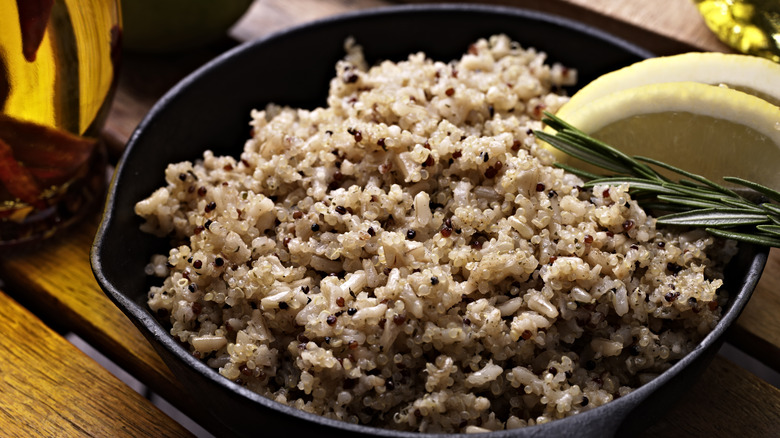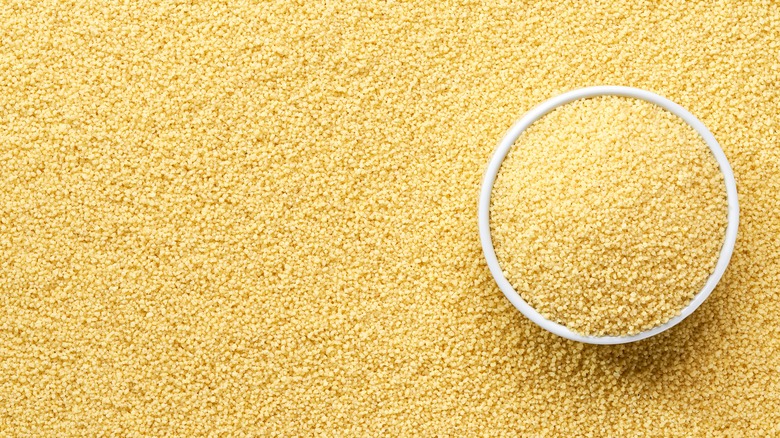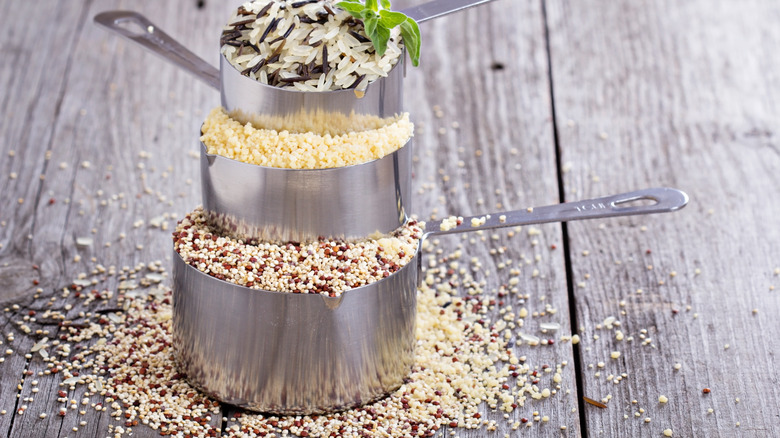The Starchy Difference Between Couscous And Quinoa
Couscous and quinoa are both tiny grain-like round ingredients. They're both cooked in place of (or with) rice or used as filling bases for salads, and they both have a stellar rep in the nutrition department. Is it really all that astonishing then for the two ingredients to be confused for one another? Couscous and quinoa may seem like two names for the same nutritious granules depending on where you are in the world, but they actually happen to be two entirely different things.
Quinoa is the seed of the Chenopodium quinoa plant, which belongs to the same family of Amaranthaceae plants that include the likes of spinach and amaranth. Native to the Andes Mountains, quinoa was first cultivated millennia ago, and it used to be an important grain in the diets of the Quechua, Inca, and Aymara peoples, along with corn and potatoes. In fact, quinoa enjoyed such importance that the Incans believed it to be sacred and dubbed it as the mother of all grains. Despite its moniker, however, quinoa is not a grain but because its nutritional profile and preparation methods are the same as one, it is referred to as a pseudograin. On the flip side, couscous is neither a seed nor a grain — it's pasta and as such, a starch! Made from a semolina dough that is rolled into small balls, couscous is a staple in North Africa, including Algeria, Tunisia, and Morocco.
Quinoa and couscous are prepared differently
Because one is a seed that's eaten as a grain and the other is a starch, there are several differences between quinoa and couscous that affect the way they are prepared and consumed, even if they can technically be used interchangeably. Quinoa and couscous can both be cooked in the same way — they are both boiled in a liquid until they absorb it all, much like rice.
One difference, however, is that quinoa has a bitter coating of saponin surrounding its seeds that couscous does not. In fact, some theories claim that when Spanish explorers returned to Europe from the Andes and brought with them corn and potatoes, quinoa was left behind because they likely ate it without removing the saponin and found it to be too bitter. This is why, while you skip rinsing couscous before boiling, washing quinoa with water before cooking to get rid of the saponin is extremely important.
Quinoa and couscous differ in terms of taste as well. Couscous doesn't have much flavor of its own, which can be a benefit because it easily absorbs the flavors of whatever it is cooked with. On the other hand, quinoa is inherently nutty and has a certain crunchiness to it that couscous lacks. Additionally, quinoa can also be ground into flour and used to make everything from bread, cakes, and muffins to fluffy pancakes, crisp crackers, and even creamy sauces.
The nutritional differences between quinoa and couscous
Quinoa and couscous not only look similar, but they also have similar nutrients in them, albeit in different proportions. For example, both contain fiber and protein, as well as nutrients such as folate, iron, manganese, and selenium. But where the selenium in a 100-gram serving of cooked couscous makes for 50% of the daily recommended intake, the same quantity of quinoa will only make up for 5% of it. On the flip side, quinoa contains higher amounts of manganese, folate, fiber, and iron but has fewer carbs.
A significant nutritional difference between quinoa and couscous is their protein value. Couscous packs 3.8 grams of protein in a 100-gram serving, which isn't substantially less than the 4.4 grams that quinoa contains — but the type of protein present in quinoa is much different. While couscous and most grains fall short in at least one of the nine essential amino acids (those that a human body cannot produce on its own), quinoa contains all of them, making it a complete protein.
Another key differentiating factor is that the pasta is made from wheat and contains gluten. Because quinoa is a seed, it happens to be naturally gluten-free, making it more suitable for those on gluten-free diets. However, quinoa does contain some proteins that are also found in gluten. Though generally considered safe for those with celiac disease, some people may be particularly sensitive to these proteins when consumed in large quantities (per Healthline).



